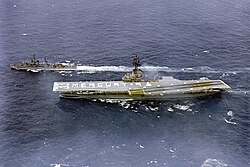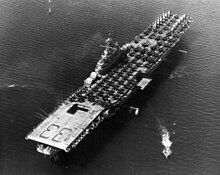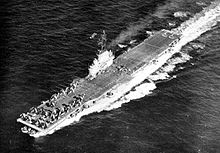USS Kearsarge (CV-33)
|
USS Kearsarge in May 1963
|
||||||||||||||||||||||
|
||||||||||||||||||||||
|
||||||||||||||||||||||
|
||||||||||||||||||||||
|
||||||||||||||||||||||
|
||||||||||||||||||||||
The USS Kearsarge (CV-33) was an aircraft carrier of the Essex class of the United States Navy . The ship entered service in 1946 and was used in the Korean War and Vietnam War. After decommissioning in 1970, the ship was scrapped in 1974.
construction
The Kearsarge was laid down on March 1, 1944 in the New York Naval Shipyard , New York City . It was named in honor of the sloops Kearsarge , built in 1861 , who sank the Confederate privateer CSS Alabama during the Civil War . The ship was launched on May 5, 1945 and could therefore no longer participate in World War II . The commissioning took place on March 2, 1946.
Mission history
1946-1952
The Kearsarge spent her first year of service on training trips in the Atlantic and the Caribbean , and in the summer of 1947 she headed for Great Britain for the first time . Between June and October 1948, she completed her first mission to the 6th fleet in the Mediterranean with Carrier Air Group 3 (CVG-3) . In January 1949 she was involved in the search for the Star Ariel . After further training trips, she circled South America in early 1950 and moved to the west coast of the United States . Between February 1950 and March 1952, she was extensively modernized in the Puget Sound Naval Shipyard , in Bremerton , Washington United States , after the conversion type SCB-27A .
1952-1956
After being put back into service on February 15, 1952, the Kearsarge CVG-101 boarded and left San Diego , California , on August 11, 1952 for a mission in the Korean War . By February 1953, the CVG-101 aircraft had flown nearly 6,000 sorties over Korea. During this deployment, she was classified as an attack vehicle (CVA) on October 11th. Upon returning to San Diego, the aircraft carrier served as the backdrop for scenes from the war film The Caine Was Her Destiny . 1953–1954 and 1954–1955 were followed by further trips to the Western Pacific with CVG-11 . From February 6 to 13, 1955, the Kearsarge supported the evacuation of 18,000 civilians and 20,000 soldiers from the Dachen Islands in the wake of the border conflict between Taiwan and the People's Republic of China .
1955–1956 followed another mission with CVG-5 in the western Pacific. In mid-1956 the aircraft carrier went back to the shipyard for six months to be modernized according to SCB-125 . The main improvements of this conversion were the installation of a closed bow and a sloping deck .
1957-1958
Between August 1957 and April 1958, the Kearsarge made her last mission as an attack vehicle in the Western Pacific. Although the aircraft carrier had been comprehensively modernized twice, it had not received the steam catapults that were necessary to operate the increasingly heavy fighter aircraft . Therefore, on October 1, 1958, it was reclassified as an anti- submarine carrier (CVS) .
1959-1964
For the remainder of the service period, the Kearsarge was assigned the Carrier Anti-Submarine Air Group 53 (CVSG-53) . During the journey from 1959 to 1960, the aircraft carrier provided disaster relief in Japan after the Ise-wan typhoon . In March 1960, Kearsarge rescued four Soviet soldiers in a storm , 1,930 miles northwest of Midway . The sailors had previously spent 49 days in their rudderless landing craft . The crew of the Kearsarge then received official thanks from the Soviet Union . In the summer of 1961, the Kearsarge cruised with the 7th Fleet in the South China Sea during the state crisis in Laos .
The aircraft carrier left San Diego in August 1962 and served as a receiving ship for the astronauts of the Mercury program . On October 3, 1962, she took in the astronaut Walter Schirra after his Mercury Atlas 8 mission . Six months later, Gordon Cooper was admitted, who had previously circled the earth 22 times during his Mercury Atlas 9 mission .
The Kearsarge was modernized for the last time between the two missions . In the shipyard in Bremerton she received a bow sonar and other improved facilities for submarine hunting (SCB-144) . This was followed by another mission to the Western Pacific between June and December 1963.
1964-1970
The Kearsarge left San Diego on June 19, 1964 San Diego for another mission and was ordered to the South China Sea after the conflict between North Vietnam and the United States escalated into the Vietnam War due to the Tonkin incident . In total, the Kearsarge completed four trips in the Vietnam War in 1964, 1966, 1967–1968 and 1969. However, as anti-submarine carriers, the aircraft and helicopters of the CVSG-53 did not take part directly in the fighting. In addition to hunting for submarines, the Grumman S-2 Tracker aircraft were used to monitor the Vietnamese coast. Some of the Sikorsky SH-3A Sea King helicopters had their anti- submarine equipment removed and the helicopters armed. So converted, they were used to rescue shot down aircraft crews in Vietnam.
1970-1974
On February 13, 1970, the Kearsarge was finally decommissioned. After three years in the reserve fleet , the ship was canceled in May 1973 and sold for scrapping in February 1974.
literature
- Alan Raven: Essex-Class Carriers . US Naval Institute Press, Annapolis 1989. ISBN 0-87021-021-1 .
- Mark Stille: US Navy Aircraft Carriers 1942-45. WWII-built ships. Osprey Publishing, Oxford 2007, ISBN 978-1-84603-037-6 .
- Stefan Terzibaschitsch : US Navy aircraft carrier. Bernard & Graefe Verlag, Bonn 2001, ISBN 3-7637-6200-0 .
Web links
- Dictionary of American Naval Fighting Ships (DANFS), Kearsarge III (CV-33) (English)
- USS Kearsarge at navysite.de (English)
- Pictures of the USS Kearsarge at navsource.org (English)
- Airborne squadron of the USS Kearsarge at gonavy.jp (English)
Individual evidence
- ↑ CVG-3. Retrieved March 5, 2016 .
- ↑ a b CV-33 KEARSARGE. Retrieved March 5, 2016 .
- ↑ CVG-11. Retrieved March 5, 2016 .
- ↑ CVG-5. Retrieved March 5, 2016 .
- ↑ USS Kearsarge Rescues Four Soviet Soldiers Adift in Pacific Ocean for 49 Days. In: history.navy.mil. April 28, 2015, accessed February 17, 2016.
- ↑ Dictionary of American Naval Fighting Ships (DANFS), Kearsarge III (CV-33)



